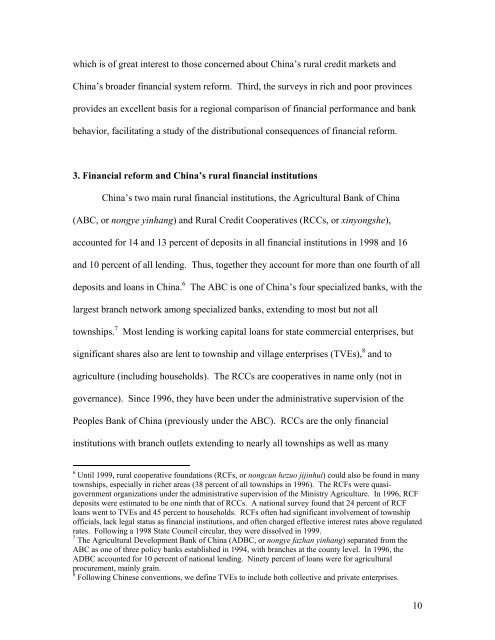Are China's Financial Reforms Leaving the Poor Behind - Harvard ...
Are China's Financial Reforms Leaving the Poor Behind - Harvard ...
Are China's Financial Reforms Leaving the Poor Behind - Harvard ...
Create successful ePaper yourself
Turn your PDF publications into a flip-book with our unique Google optimized e-Paper software.
which is of great interest to those concerned about China’s rural credit markets andChina’s broader financial system reform. Third, <strong>the</strong> surveys in rich and poor provincesprovides an excellent basis for a regional comparison of financial performance and bankbehavior, facilitating a study of <strong>the</strong> distributional consequences of financial reform.3. <strong>Financial</strong> reform and China’s rural financial institutionsChina’s two main rural financial institutions, <strong>the</strong> Agricultural Bank of China(ABC, or nongye yinhang) and Rural Credit Cooperatives (RCCs, or xinyongshe),accounted for 14 and 13 percent of deposits in all financial institutions in 1998 and 16and 10 percent of all lending. Thus, toge<strong>the</strong>r <strong>the</strong>y account for more than one fourth of alldeposits and loans in China. 6The ABC is one of China’s four specialized banks, with <strong>the</strong>largest branch network among specialized banks, extending to most but not alltownships. 7Most lending is working capital loans for state commercial enterprises, butsignificant shares also are lent to township and village enterprises (TVEs), 8 and toagriculture (including households). The RCCs are cooperatives in name only (not ingovernance). Since 1996, <strong>the</strong>y have been under <strong>the</strong> administrative supervision of <strong>the</strong>Peoples Bank of China (previously under <strong>the</strong> ABC). RCCs are <strong>the</strong> only financialinstitutions with branch outlets extending to nearly all townships as well as many6 Until 1999, rural cooperative foundations (RCFs, or nongcun hezuo jijinhui) could also be found in manytownships, especially in richer areas (38 percent of all townships in 1996). The RCFs were quasigovernmentorganizations under <strong>the</strong> administrative supervision of <strong>the</strong> Ministry Agriculture. In 1996, RCFdeposits were estimated to be one ninth that of RCCs. A national survey found that 24 percent of RCFloans went to TVEs and 45 percent to households. RCFs often had significant involvement of townshipofficials, lack legal status as financial institutions, and often charged effective interest rates above regulatedrates. Following a 1998 State Council circular, <strong>the</strong>y were dissolved in 1999.7 The Agricultural Development Bank of China (ADBC, or nongye fazhan yinhang) separated from <strong>the</strong>ABC as one of three policy banks established in 1994, with branches at <strong>the</strong> county level. In 1996, <strong>the</strong>ADBC accounted for 10 percent of national lending. Ninety percent of loans were for agriculturalprocurement, mainly grain.8 Following Chinese conventions, we define TVEs to include both collective and private enterprises.10















